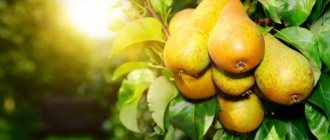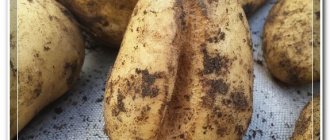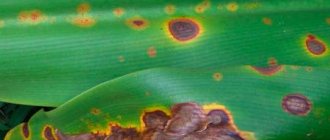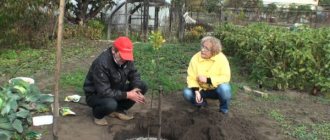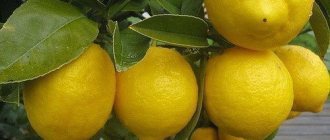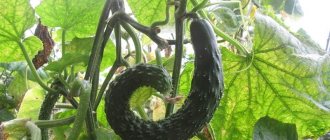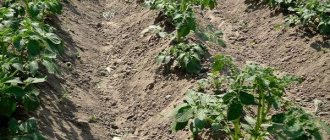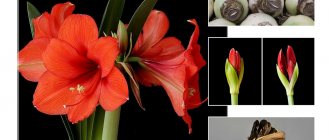Where and how does the pear grow in the garden and in the wild?
Pear is a vigorous deciduous tree up to 8–15 m high, with a powerful taproot system that goes deep into the soil. Blooms in spring, April-May. The fruits ripen from July to October depending on the variety and region.
Southern pear varieties originate from wild forest pears, and more winter-hardy northern varieties come from crossing forest pears and southern varieties with wild Ussuri pears.
All wild pears (forest, Ussuri, oleaster, willow) in their natural growth zone and regions similar in climate can be used as rootstocks for cultivated varieties.
Table: features of different types of wild pears
| Name/properties | Drought resistance | Where found in nature | Regions of natural growth | Winter hardiness | Regions of use as a rootstock |
| Ussuri pear | Low | Wet mixed forests, along the edges and river banks | Far East of Russia | Very high (-40…-45°C) | Far East, Siberia |
| Forest pear | Average | Forest edges and glades | Central and southern regions of Russia, Ukraine | Medium (-25…-35°C) | All Ukraine, center and south of Russia |
| Pear pear | Very high | Open woodlands, dry rocky slopes | Crimea, Caucasus | Winter-hardy only in southern regions | Southern arid regions of Ukraine, Crimea, Caucasus |
| Willow pear | Caucasus |
Photo gallery: wild pear species
Ussuri pear grows in mixed forests
The fruits of the Ussuri pear can be tasted in the Far East
Forest pear grows on forest edges and clearings
Forest pear fruits are popular in Ukraine, central and southern parts of Russia
Pear pear can grow on rocky slopes
The fruits of the shaggy pear can be found in arid regions
Willow pear also prefers dry slopes and woodlands
The fruits of the willow pear can be tasted in Ukraine, Crimea and the Caucasus
Fruiting dates for cultivated and wild pears
Dates for pear fruiting to begin:
- wild pears and seedlings of cultivated varieties - 9–15 years after planting;
- grafted onto a seed rootstock - after 5–10 years;
- grafted onto a dwarf rootstock - after 2–4 years.
On a seed rootstock, a pear grows and bears fruit for 50–100 years, on a dwarf rootstock – no more than 20–40 years.
In my garden, a huge wild pear, almost six meters high, planted by my grandfather in the 1970s and successfully survived the extreme winter of 1978 with forty-degree frosts, still grows and bears fruit abundantly every year. In the early 90s, my grandfather grafted several cultivated varieties onto seedlings from her seeds. At first, the grafting developed poorly due to the terrible thickening in that corner of the garden. When I eliminated the excess thickets in the early 2000s, leaving only pear trees there, the trees immediately gave a powerful growth and bloomed after 1-2 years.
Features of pear grafting depending on the region
A dwarf pear is a tree of an ordinary cultivated variety, grafted onto a special rootstock - a vegetatively propagated form of quince. It grows no higher than 3–4 m.
Pear on quince can only grow in southern regions with warm winters. It blooms there 2–3 years after planting. In central Russia, quince freezes out.
Pear on quince blooms 2–3 years after planting
Beginner gardeners often confuse true quince with the more frost-resistant Japanese quince (Chaenomeles), but Chaenomeles is not suitable for pear grafting.
Due to the lack of zoned winter-hardy dwarf rootstocks, gardeners in the Moscow region, Leningrad region, Urals and Siberia often experiment by grafting pear onto ordinary red rowan, serviceberry and chokeberry (chokeberry). For experienced specialists, such vaccinations are often successful, although not very durable. On serviceberry and chokeberry, the pear grows short due to poor compatibility with the rootstock, but such grafting must be regularly updated due to the rapid death of grafted branches.
Photo gallery: possible rootstocks for pears
Quince can serve as a rootstock for pears only in the southern regions
Japanese quince (chaenomeles) is not suitable for pear grafting
Experts graft a pear onto a rowan tree
Chokeberry can also be used as a pear rootstock
Irga is also considered an unreliable rootstock for pears, but is used in cold regions
First year pear
This often happens that a pear planted in the spring produces one or two flowers. With warmer temperatures and sufficient nutrients, the tree quickly begins to develop. The question arises: should I cut off the first-year flowers?
In this case, the same principle applies as in any other.
The flowers do not need to be removed. They will not harm the culture itself.
But it is best to remove the buds from the tree immediately. They will only drain the vitality of the plant, but will not become full-fledged pears.
Harvesting and storing pears
Different varieties of pear have their own ripening, harvesting and storage periods:
- summer varieties ripen in July-August and are stored for no more than 2 weeks;
- autumn varieties ripen in late August - early September and are stored for 1-2 months;
- winter varieties ripen at the end of September - October, and are stored for 3-5 months.
Winter varieties of pears have time to ripen only in the southern regions.
Summer varieties are harvested when fully ripe and used immediately. Autumn and winter varieties are harvested while they are still hard, when the seeds turn dark brown. Before eating, they must ripen in storage for 2 weeks to 2 months, depending on the variety. All pears are stored in the refrigerator or in a well-ventilated cellar with a temperature just above zero degrees.
You need to pick pears carefully, without damaging the fruits and branches.
When harvesting, it is important to pick the fruits correctly. To do this, you need to hold the branch on which the fruit grows with one hand, and with the other, carefully take the pear and turn it around the stalk so that it separates from the branch. For storage, fruits are collected only by hand. All kinds of fruit pickers damage pears and fruit branches, and the harvest that has fallen to the ground is deformed from the impact and is not suitable for storage.
Why the pear tree doesn’t bloom, what to do
You should immediately clarify that if the tree is less than 3 years old, the lack of flowering is absolutely normal. If a young tree is from 3 to 10 years old and has not yet bear fruit, there is no need to rush to get rid of it. It is worth finding out what year a pear of a given variety blooms. If, according to age criteria, she should already have done this, she should look for the cause of the anomaly and begin to eliminate it.
Why doesn't the pear bear fruit?
Pear is a rather difficult crop to grow. The optimal conditions for its comfortable development are:
- fertile light soil;
- well-lit, sunny area;
- regular care.
For your information! With the right choice of variety, suitable conditions and proper care, a pear can produce a good harvest for about 50 years.
In the absence of these conditions, deviations in the formation of ovaries and a decrease in the quality of fruiting are possible.
The main reasons for the lack of flowering of a pear for the first time are:
- Prolonged frosts in winter and frosts in spring. Pear is a heat-loving plant that also reacts poorly to sudden temperature changes. Pear branches and buds are prone to freezing. After a frosty winter, the tree may die. In this case, the buds will not bloom at all, the branches become dry, without signs of life, and the bark begins to burst. A signal of tree damage due to unexpected frosts is frozen buds or blackening of already blossoming leaves.
- Shaded place. The pear tree needs sunlight. If there is a lack of it, it will not develop.
- Dense crown. The branches of this plant are characterized by rapid growth. If you don’t take care of this and don’t trim it on time, all the energy of the tree will be spent on providing useful substances to the green mass, and not on the formation of ovaries. In addition, the thickening does not allow sunlight to penetrate to the buds and interferes with high-quality ventilation of the crown.
- Root rotting. Pears do not tolerate heavy, wet soil well, as the roots can rot. In addition, groundwater passing close to the surface of the earth washes away nutrients.
- Incorrect landing. The root collar should be at soil level. If the planting occurs deeper, the soil will have to be raked; if the planting is high, hilling is necessary.
The poor condition of the tree can be caused by several other quite serious factors:
- Lack of nutrients. Buds for the future harvest are laid in the summer. If at this time the tree suffers from an insufficient amount of necessary substances, it will not be able to form buds at all or their quality will be very low.
- Insects that harm trees and fruits. There are situations when flower buds do begin to form, but before they have time to bloom, they fall off. In such cases, insects or their larvae are most often to blame. The most famous pear lovers are the goldentail, the honey beetle, and the flower beetle.
- Diseases affecting the tree. The absence of flowering can signal a variety of diseases that can not only delay development, but even completely destroy the tree. The most dangerous in this regard are scab, powdery mildew, rust, cytosporosis, fire blight, and white spot.
Cytosporosis
Note! There are times when a pear tree unexpectedly blooms a second time in the fall. This is not a reason to celebrate. The second flowering is a sign of a disease such as proliferation. Repeated flowering weakens the tree; buds that bloom in the fall will 100% not bloom the next year.
What pests and diseases can affect ornamental climbing pears?
The climbing ornamental pear is characterized by disease resistance. But still, to help a strong immune system, it is worth carrying out regular treatments with chemicals. This is real protection against common dangers - black spot, leaf curl and fire blight.
- Due to bacterial burn caused by Enterobacteria_ceae microorganisms, the foliage suffers, and accordingly, the damage affects the decorativeness of the tree. The appearance of such a tree resembles the state after a fire. This disease is treated with copper preparations, with the preliminary removal of all affected areas of the ornamental pear plant.
- When affected by brown spot , the first thing that catches your eye is the red spots (even on young leaves). After some time, the spots turn gray and then black. If left untreated, the disease will spread to the entire green mass. The main causative agent of brown spot is the Entomosporium fungus, which becomes active in the spring and autumn. It is possible to get rid of it with the help of the drugs “Topaz” and “Fitosporin_M”.
- With leaf curl (a fairly rare disease), there may not be a single leaf left on the ornamental pear tree. They thicken, become curly and acquire a red-yellow color. To protect the ornamental pear, diseased parts are immediately pruned and burned. To prevent curling in early spring, before buds appear, treatment with copper sulfate is necessary.
Decorative pear is actively used by landscape designers to decorate garden plots. But in order to grow it beautiful and healthy, it is necessary to take into account both the subtleties of choosing a suitable variety and caring for a climbing ornamental pear.
What else can you do in the pear orchard in spring?
Graft
Experimental gardeners, as a rule, resort to this procedure in the following cases:
- A tree has grown from a seed (wild), and there is a need to graft a cultivated variety onto it (varietal pear).
- I am not satisfied with the previously planted variety, and there is a desire to regraft with a more suitable one.
- I want to have several varieties on one tree at once.
By the way! The site already has an article on how to graft a pear , which explains all the main methods of grafting a fruit tree .
Advice! If the bark in the lower part of the trunk of your pear tree was seriously damaged in winter by rodents (mice or hares), so to speak, gnawed into a ring , then to save the tree, you can graft the pear with a bridge .
Transplantation and planting
Of course, spring is a great time to start a new pear orchard (plant a young seedling). You can also perform the transplant procedure, for example, if the place turns out to be unsuitable, and you must save the earthen ball when you dig up the seedling.
about spring and autumn here .
Video: how to properly transplant a fruit tree
As you understand, caring for a pear in the spring is not at all so difficult: all activities are standard (except for bending the branches, which is only relevant for a pear and partly for an apple tree). But if you do everything correctly and in a timely manner, then the pear will only delight you with a tasty and large harvest.
How to help a pear blossom
Why does the apple tree not bloom or bear fruit?
Knowing the reasons and factors influencing the fruiting of a pear, you can understand what to do to make the pear bloom for the first time.
How to make a pear blossom:
- Choosing the right tree. The best option for growing in summer cottages is pears, which bear fruit in the sixth year. Experienced gardeners recommend buying seedlings in special nurseries or centers, or in well-tested places. That is, where there are guarantees that they will sell exactly the variety that is needed, and not a late-bearing plant or wild plant.
- Pollination. You should definitely take care of pollinating plants. You should not plant just one tree. A pear must have neighbors - several pears of different varieties. In this case, there is the possibility of cross-pollination, and the likelihood of fruiting increases significantly.
- The correct choice of variety, taking into account zoning. You should know the climate when choosing a plant. If the location is characterized by harsh winters, cold-resistant varieties are selected. If there are frequent frosts, it is better to choose late-ripening plants, since they bloom later when the likelihood of frost decreases.
- Choosing the right site for planting. It is better to select a sunny place, preferably protected from the winds. In addition, pear does not develop well in heavy clay soils; it prefers sandy or loamy soil that is not prone to getting wet. If there is no choice, then drainage will help correct the situation.
Artificial pollination of pear
Important! Pear does not tolerate too acidic soils (optimal acidity is 7 pH). To lower the acidity level, you can add a little limestone to the soil.
- Regular watering. In drought conditions, the tree does not have enough strength to ensure flowering. Timely watering can restore balance. Watering should be done on a cloudy day or after sunset with warm water. To improve the effect, dig a small groove around the pear and pour 3-4 buckets of water into it.
- Crown formation. Pear branches grow very quickly. To direct resources to the formation of fruits rather than green mass, the crown should be regularly thinned. In addition, such actions help the sun's rays penetrate the kidneys.
- Feeding. Soil resources are constantly being depleted; in order to bear fruit, a tree needs to constantly replenish its mineral reserves. For the full development of the pear, organic fertilizers should be added to the soil around it in the fall and spring - humus, chicken manure, ash. If necessary, you can replace organic matter with complex fertilizers. Additionally, in the spring, before flowering begins, fertilizing is introduced in the form of a solution of urea or ammonium nitrate. After flowering, the pear is fed with potassium phosphate fertilizers.
- Disease and pest control. The presence of disease or insect damage affects the viability of the pear. As a disease prevention, you can use a solution of Bordeaux mixture (the first time 3%, the next times - 1%). Fungicides or insecticides will help control pests. But the best way to get rid of this problem is preventative work: removing dry, affected branches, removing fallen leaves, whitewashing trunks.

